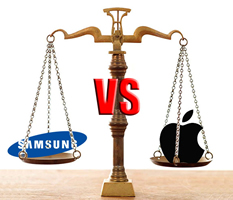 A 20 page verdict form and 100 pages of instruction explaining the same would’ve surely slowed any trial. However, this wasn’t the case in the latest lawsuit between Apple and Samsung, as the former emerged the victor in what was termed as the biggest tech lawsuit of this century. Thought Apple emerged victorious, it wasn’t as flawless as the company would have expected. The damages summed up to a little over $1 billion, but Apple wanted much more for the infringements. The Cupertino Company’s cadre of lawyers managed to convince the jurors to pass the verdict in their favour. Even though it wasn’t a landslide for Apple, the victory was convincing nonetheless.
A 20 page verdict form and 100 pages of instruction explaining the same would’ve surely slowed any trial. However, this wasn’t the case in the latest lawsuit between Apple and Samsung, as the former emerged the victor in what was termed as the biggest tech lawsuit of this century. Thought Apple emerged victorious, it wasn’t as flawless as the company would have expected. The damages summed up to a little over $1 billion, but Apple wanted much more for the infringements. The Cupertino Company’s cadre of lawyers managed to convince the jurors to pass the verdict in their favour. Even though it wasn’t a landslide for Apple, the victory was convincing nonetheless.
First, let us look into why Samsung got into these problems to begin with. According to Title 35 of the US code, section 271, a company is likely to be charged with infringement if a company makes use or sells a patented invention in the United States without prior permission of the parent company. So the organization under the scanner would be the US subsidiaries of Samsung. Their parent organization i.e. Samsung Korea cannot be held under the same law as it doesn’t carry out its business in the US. However they can be held accountable under another part of the same section i.e. any company inducing patent infringements is liable to be charged as an infringer.
The Jurors were waged with the arduous task of determining whether Samsung’s devices Infringed Apple’s IP and whether Samsung’s Korea was inducing the infringement. Also the Jury was to decide whether Samsung had done so willingly, as this could give Judge Koh the power to triple the damages. A third decision had to be made regarding the validity of Apple’s patents, i.e. whether they were really Apple’s or there is a third part owner of these patents. A total of four design and three utility patents were under the scanner in this lawsuit. One of them devises a method for the bounce back that occurs when the user scrolls beyond the end of a document or a web page. Single and double finger scrolling complete the remaining utility patents. Apple’s major success came with the bounce back feature, where a total of 21 Samsung phones were found infringing this patent. Apple also had partial success in the remaining utility patents. The design patents also narrated a similar story, with one of those patents increasing the penalty on Samsung. The remaining design patents where phone specific, but did increase Apple’s earnings.